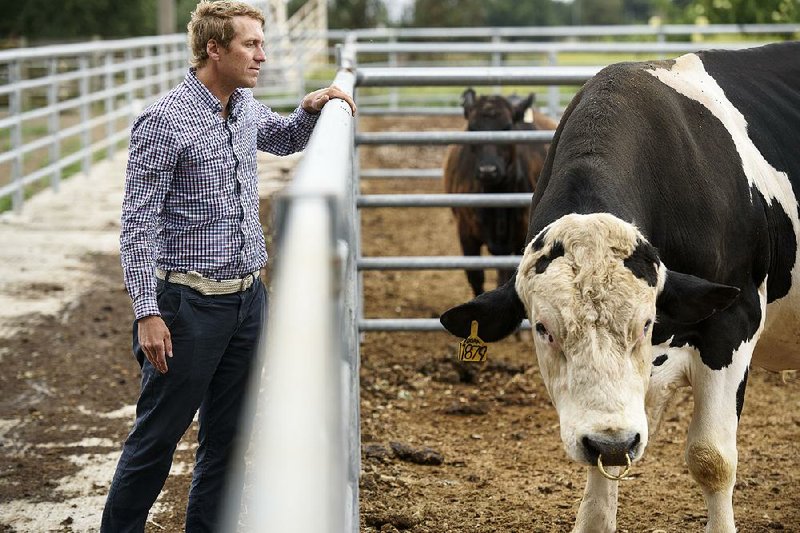For nine nerve-racking months beginning in the summer of 2014, Dan Carlson waited for his lab experiments to be born.
Carlson and his team at the biotechnology startup Recombinetics had made a tweak in the genetic code of dairy cattle in an attempt to prevent the animals from growing horns. Now, that edited DNA was being copied over to the cells in fetuses growing in their surrogate mothers.
No one had tried this before, so it wasn't clear it would work. And compared with the mere days it takes for the cutting-and-pasting of genes to complete in culture dishes, the monthslong pregnancies were agonizingly slow. "You hope everything is going well," Carlson said. "You're expecting it to come out without any horns or horn buds, but you just don't know."
As is common with cloned animals, most of the embryos never made it. But Buri and Spotigy, two calves born in April 2015, were free of the telltale bumps that eventually sprout into horns. That meant they would be spared the fate of millions of U.S.-raised cattle, whose horns are destroyed with a hot iron or toxic paste shortly after they're born or are sheared off when they're older. It's a practice Carlson knows his own father, a farmer, struggled with. The painful procedure is done to prevent the cows from goring one another or their human overseers, but People for the Ethical Treatment of Animals and other animal-welfare groups vociferously oppose it. (PETA isn't a big fan of gene editing either, which the organization considers animal experimentation.)
Scientists like Carlson -- who are manipulating DNA to not only improve animal welfare but also create better crops and treat human disease -- are one of the hottest commodities today in biotechnology. U.S. job postings for the profession surged 64 percent over the last two years, according to the job search site Indeed.com.
People like Carlson can do this work thanks to two methods, both discovered less than a decade ago, that have made gene editing cheaper and easier. The technique used to develop Carlson's hornless cows is called transcription activator-like effector nuclease; the more famous one, which came slightly later, is called clustered regularly interspaced short palindromic repeats. Carlson is now involved in several projects that employ gene editing in animals, including one that keeps pigs from reaching puberty so they need not be castrated.
Carlson first became fascinated with genetics as a high school student, when his father started planting genetically modified corn. "They were taller. They didn't have any problems standing up. They were essentially the best crop that I ever saw my dad produce," recalls Carlson, who went on to get his Ph.D. in animal sciences with an emphasis in biotechnology and molecular genetics. "From that moment on, I was like, 'This technology is for real. It can really make a difference.'"
In the U.S., the Department of Agriculture and the Food and Drug Administration have taken different stances on gene editing. The former has been hands-off; the latter proposed guidelines in 2017 that would treat gene editing in animals as a kind of drug, and therefore would require companies to seek approval introducing altered animals to the food supply.
Neither Spotigy nor Buri is alive today. The former was slaughtered last year so scientists could examine his meat (it was normal). Buri was euthanized last month, but not before becoming a father to six horn-free calves. One, named Princess, is female. She should be old enough in a little more than a year to have her own calves and start producing milk. Recombinetics plans to examine the milk for signs of abnormalities.
Carlson is so confident about the milk's safety, he said he wouldn't hesitate to feed it to his three children. Jennifer Kuzma, co-director of the Genetic Engineering and Society Center at North Carolina State University, is more cautious. She notes that gene editing tools sometimes slip up by making insertions or deletions in unintended parts of the genome, though Carlson's team looked for these so-called off-target events and found none. Cloning the cells, which is often an essential process in gene editing, can also produce abnormalities, she said.
Kuzma also said there needs to be a broader conversation about the underlying ethics of the technology. "With these genetic engineering techniques becoming easier to implement and more powerful too, we're at a critical point where things could change in the natural world," she said.
In May, Recombinetics moved one step closer to commercializing its technology, announcing a partnership with Canadian semen distributor Semex. The two companies plan to spend the next few years working with regulators in Canada and the U.S. Absent significant obstacles, we may live in a world in 20 years in which no cow would ever need to be dehorned, Carlson said. "Whether this strain of animals takes off, it's really up to the government and public acceptance," he said. "I can't do a lot about those things. I've just got to do my job."
Business on 07/21/2018

